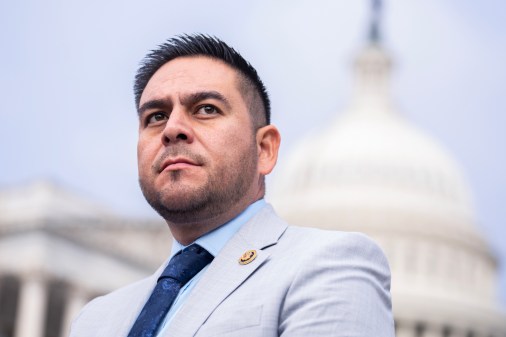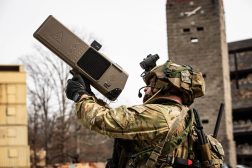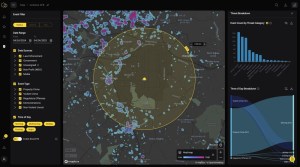NORAD commander says hundreds of drone incursions were detected at US military installations

The Pentagon needs more technology and expanded authorities to deal with large numbers of incursions over U.S. military installations by small unmanned aerial systems, the commander of North American Aerospace Defense Command and U.S. Northern Command told lawmakers.
NORAD and Northcom chief Gen. Gregory Guillot revealed more details Thursday about widespread, recent incidents that highlight the drone problem.
“The primary threat I see for them in the way they’ve been operating is detection and perhaps surveillance of sensitive capabilities on our installations,” he said during a Senate Armed Services Committee hearing. “There were 350 detections reported last year on military installations, and that was 350 over a total of 100 different installations of all types and levels of security.”
High-profile incidents that were reported last year include UAS sightings at multiple bases in New Jersey amid a broader slew of public reports of mysterious drone activity in that part of the country. At the time, a senior defense official said the Pentagon was “frustrated” by these types of events.
Complicated regulatory structure and limitations on UAS countermeasures stemming from concerns about flight safety and privacy have created “significant vulnerabilities that have been exploited by known and unknown actors,” Guillot told lawmakers in written testimony for Thursday’s hearing.
Not all commanders have the authority to use weapons to defend their bases from these types of drone incursions. Only about half are considered “covered installations,” he told lawmakers.
Section 130i under Title 10 of U.S. Code pertains to protection of “certain facilities and assets from unmanned aircraft.”
“I would propose and advocate for expansion of 130i [authorities] to include all military installations, not just covered installations,” Guillot said during the hearing. “I’d also like to see the range expanded to slightly beyond the installation, so they don’t have to wait for the threat to get over the installation before they can address it, because many of these systems can use side looking or slant range, and so they could … surveil the base from outside the perimeter. And under the current authorities, we can’t address that.”
Sen. Tom Cotton, R-Ark., said the current arrangement “sounds crazy.”
“It doesn’t show a lot of common sense. I mean, base commanders at every base around America … have the authority and they have the capability to protect their perimeters. Say, if some terrorists got a dump truck and drove it through the front gate or were trying to breach the perimeter fence, we would expect base commanders to protect their base with force if necessary,” he said at the hearing.
He noted that he and Sen. Kirsten Gillibrand, D-N.Y., are pushing legislation to give commanders the legal authority they need and the capability required to protect their bases from these kinds of incursions, “and then hold them accountable for doing so.”
Cotton said he hopes the legislation will be passed into law this year.
Officials are also concerned about drone activity along the southern border, including by drug cartels or other organizations and people.
Guillot added that he’d like 130i authorities to be expanded to allow “seamless exchange of data” about UAS activity with other agencies like the Department of Homeland Security.
Meanwhile, the Defense Department is taking steps to try to beef up its defenses.
Northcom and NORAD have shifted resources and personnel to establish a counter-drone operations branch within their headquarters.
In November 2024, Pentagon leaders directed Northcom to serve as DOD’s “synchronizer, integrator, and/or coordinator” of counter-small UAS activities within the continental United States and Alaska, Guillot noted in written testimony.
“This effort will require investment in robust and evolving mitigation technologies suitable for use in the United States, alignment with interagency and industry partners, and policy and statutory changes that balance safety, privacy, and defensive requirements,” he wrote.
A few months ago, Northcom and NORAD hosted counter-drone technology demonstrations at an event known as Falcon Peak in Colorado.
“Thanks to extraordinary support from the U.S. Army’s 4th Infantry Division, 10th Special Forces Group (Airborne), the Federal Aviation Administration (FAA), the Colorado National Guard, and many others, demonstration participants tracked and engaged live sUAS targets in complex, realistic scenarios over a number of days and nights within military Special Use Airspace. The demonstration provided important insights that the Commands and our partners will continue to build on,” Guillot wrote, noting that the next iteration of Falcon Peak is slated for this summer and is expected to include more vendors, participants and systems.
Last month, the Defense Department released a sources sought notice to industry about the event.
The gathering, dubbed Falcon Peak 25.2, will provide a venue for vendors to demonstrate the ability of their tech to detect, track, identify and defeat various small drones in the Group 1 and 2 categories “using LCD effects,” according to the notice.
NORAD and Northcom will “provide, operate, and deploy UXS platforms capable of addressing cross-domain and previously unseen threat profiles, including low-emission and no-emission (dark) UAS. FP25.2’s intent is to observe the readiness of commercially available systems, specifically those with a Technology Readiness Level (TRL) of 7, 8, and 9, employed as part of an overall effort to unify military base Force Protection measures falling under the purview of” the commands, per the notice.






